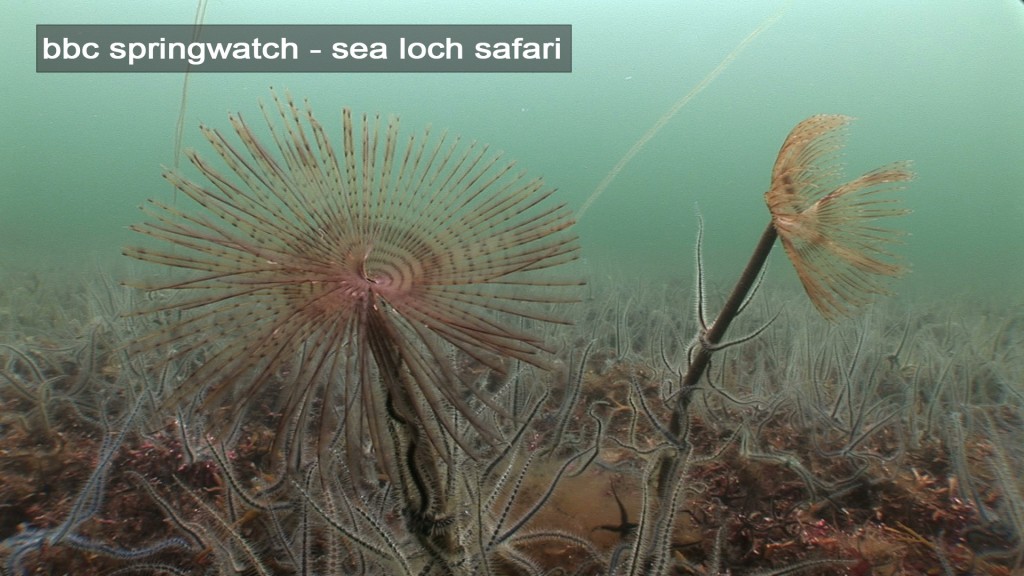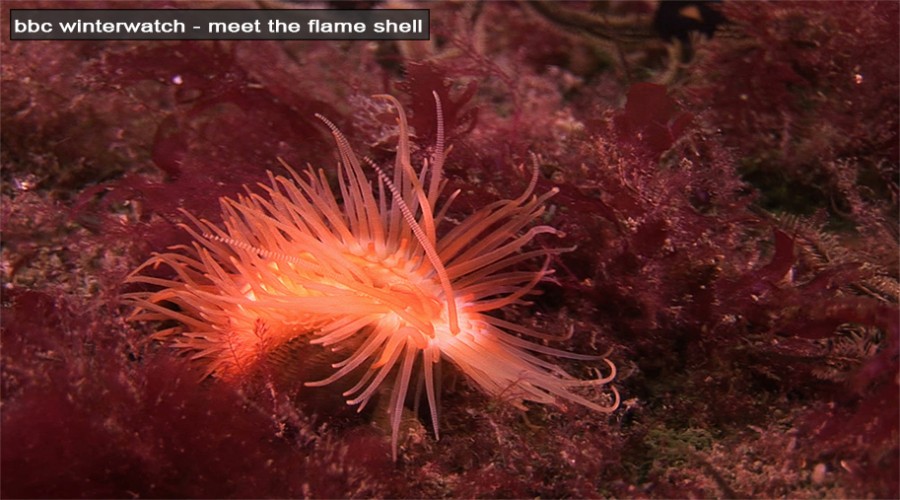BBC Winterwatch – Meet the Flame Shell
Posted on January 28, 2015
BBC Winterwatch beamed live from the frozen heights of the Cairngorms this January. In amongst pine martens, squirrels, and burying Martin Hughes-Games in the snow, you may have seen the bright orange flame shell, master builder of a unique habitat. Andy filmed this feature late in 2014 helped by Sue Scott, a marine biologist, writer, and photographer who lives on the beautiful banks of Loch Carron.
Filming flame shells underwater was fascinating. We watched spellbound as these bivalves flicked around like underwater castanets, imitating Animal from the Muppets. But while diving with them, the magical process of how they build was hidden. So we decided to re-home a few flame shells in a large tank for a few days, surrounded by their favourite nest materials, and see what happened.
Nothing at first. Then, slowly, they started to build. An alien-like red limb emerged from the heart of the flame shell, strong enough to lift stones heavier than itself. A gland spun byssal threads that knit the shells, pebbles, and maerl into a labyrinthine nest. This has never been filmed before.
The way flame shells build their nests is amazing. But what’s even more spectacular is what happens next. Just six nests can support 250 species. When they’re able to flourish, flame shells can convert many square metres of once-barren seabed to rich habitat. They transform underwater wastelands into rich ecosystems; build a marine Dubai from the underwater desert.
We hope you enjoy the Winterwatch film as much as we loved discovering Loch Carron’s flame shell.
______________________
Images by Andy, broadcast by BBC2, words by Jackie
Scarborough South Bay: Day to night time-lapse
Posted on November 3, 2014
People say the holy grail of time-lapse photography is the day-to-night sequence. I’ve been working hard to master this technique lately.
Scarborough’s South Bay, a short walk from my home, is a beautiful place to hone my skills.
This sequence was filmed on Sunday 3rd November, between 3:30pm and 5:30pm. It captures the tail end of half term’s bustle; the final rush of tourists for 2014.
I’ve learned that the real essentials of time-lapse photography are: thermal underwear, a warm coat, hat and gloves, a camping chair, a flask of tea, a head lamp, leave the dog at home, and be willing to answer questions from passersby.
I hope you enjoy watching from a warm and cosy spot.
______________________
Images and words by Andy
The last seahorse in Studland?
Posted on September 23, 2014
We went to Dorset to film seahorses in August. We were planning to tell their life cycle story: seahorse breeding time, courtship displays, and how male seahorses are the ones to give birth.
Unfortunately, after many hours of searching, with the help of local experts, we found just one lonely seahorse: the only seahorse sighted in Studland this year. You may have seen this in the news a few weeks ago.
We also found unrestricted anchoring and destructive mooring systems that tear up the eelgrass beds in the bay.
So we made this film instead, because we believe there is a way to save the seahorses while still having fun on boats. It will take a bit of will – and a bit of money.
Please share our film and help to give Studland’s seahorses a voice and a chance.
Sign up to support Studland being designated a Marine Conservation Zone here: http://bit.ly/1ol58ZC
______________________
Images by Andy, words by Jackie
BBC Springwatch – Sea Loch Safari
Posted on August 14, 2014

BBC Springwatch showed a 5-minute feature of Lolo Williams snorkelling in Loch Sween. The BBC film crew filmed the shallow water part of this film with Lolo snorkelling and added Andy’s wildlife clips to complete the film. It’s now up on the BBC website, so if you missed it, or want to see it again, here’s the link.
________________________
Stock images by Andy, broadcast by BBC2.
BBC Springwatch – Cuttlefish Feature
Posted on August 7, 2014
BBC Springwatch showed a 5-minute feature of Andy’s cuttlefish footage in May this year. It’s now up on the BBC website, so if you missed it, or want to see it again, here’s the link.
The story covers the life cycle of these fascinating creatures. Most filming took place in Spring and Summer 2013, along the south coast of England, between Selsey and Lands End. Most of the footage included in this BBC film was shot at Babbacombe in Devon. The intimate mating shots were finally captured in Spring 2014, when Andy grabbed a window of opportunity between plankton blooms and southerly winds to film the key sequence.
Filming cuttlefish was an amazing experience. They are highly intelligent and seem to watch us as much as we watch them. We felt privileged to be accepted in their midst, to spend so many hours in the water with them, watching spellbound as they behaved so naturally in front of the camera.
We will produce our own short film about cuttlefish later this year, where we will delve into the story around fishing practices and the lack of protection for these incredible undersea creatures.
______________________
Images by Andy, broadcast by BBC2, words by Jackie

